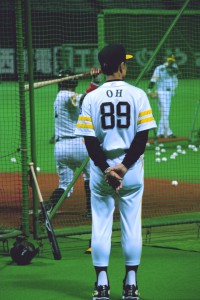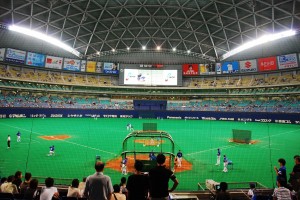Ever since 1872, when professor Horace Wilson explained the game of baseball to his students at Kaisei Gakko (now Tokyo University), the Japanese have been obsessed with the American pastime.

Americans have been familiar with some aspects of baseball in Japan, but generally that knowledge was limited to home run leader Sadaharu Oh and Japanese baseball’s attempt to preserve Oh’s home run record at the expense of former MLB players. However, Hideo Nomo, Ichiro, and the fact that Japan has won both World Baseball Classics have given more thoughtful attention to baseball in the Far East.
What exactly is Japanese baseball? Well . . . it’s baseball, although on a somewhat smaller scale than Major League Baseball: Smaller ball, smaller strike zone, and smaller field. Major corporations own each team, which is reflected in the teams’ names: Yomiuri Giants (large national newspaper), Seibu Lions (department store/railway conglomerate), etc. Only one team, the Yokohama BayStars, does not use its corporate owner’s name.
There are two leagues in Nippon Professional Baseball – the Central and Pacific – and each have six teams. As in MLB, one league – the Pacific – employs the DH. Each team has only one minor league team, a situation Bobby Valentine protested during his tenure as manager of the Chiba Lotte Marines. “It’s impossible to play,” Bobby V. said during a January talk at the Japan Society in New York, “Simple addition tells you your major league team as 25, the rest are on one team . . . It’s impossible for the players to play to develop . . . with those other 55 players, sometimes 50 players on one team.”

The major leaguers (called ichi gun in Japanese) play a 144-game season, as opposed to the 162 games played in MLB. Ties are allowed in Japanese baseball; a game is considered over, regardless of the score, at the end of 12 innings. NPB reasons that trains in Japan stop running at midnight, which could leave more than a few fans stranded.
While the same basic rules of baseball are observed by both MLB and NPB, the style of play is somewhat different. In Japan you’ll see more fundamental baseball because managers there subscribe to the theory that if you score first, you’re more likely to win. It’s important for them to get a man on in the first inning, move him over by bunting or with a hit-and-run play, and score him with a single rather than a thunderous home run.

Another interesting difference between Japanese baseball and our brand of baseball concerns makeup days for rainouts. When a postponement is inevitable due to nasty weather conditions, MLB teams look at their schedules and squeeze in a makeup game on a day both teams have free. Not so in Japan. NPB teams play makeup games after the regular season ends and before the playoffs (known as the Climax Series) begin.
So let’s talk about the playoffs. The name “Climax Series” may sound a little odd to us, but it’s all about marketing. According to Wayne Graczyk, an American who has lived in Japan and covered the Yomiuri Giants for thirty years, NPB wanted to give the series a catchy title. Catchy titles aside, the other strange thing about the Climax Series is that the first place team receives a one-game advantage and home field advantage to start the series, meaning the first place team has a 1-0 record before the best-of-three series even begins. The same holds true for the Japan Series, which pits the winner of the Climax Series against the division winners, who also receive a one-game lead before the best-of-five series. NPB developed this structure to reward the division winners with every possible chance to win the Japan Series.
With those exceptions, it’s essentially the same game played by the same rules, but there is a passion and spirit of dedication – on the part of both the players and the fans – that is hard to match anywhere else in the world. The game is entertaining, but the best part about the Japanese version is the atmosphere, which can’t be described in just a few words. So, next month I’ll talk about Japanese stadiums, ballpark food, and the fans.


![Reblog this post [with Zemanta]](http://img.zemanta.com/reblog_e.png?x-id=b19b52f3-a145-4711-a279-9017775809e3)








